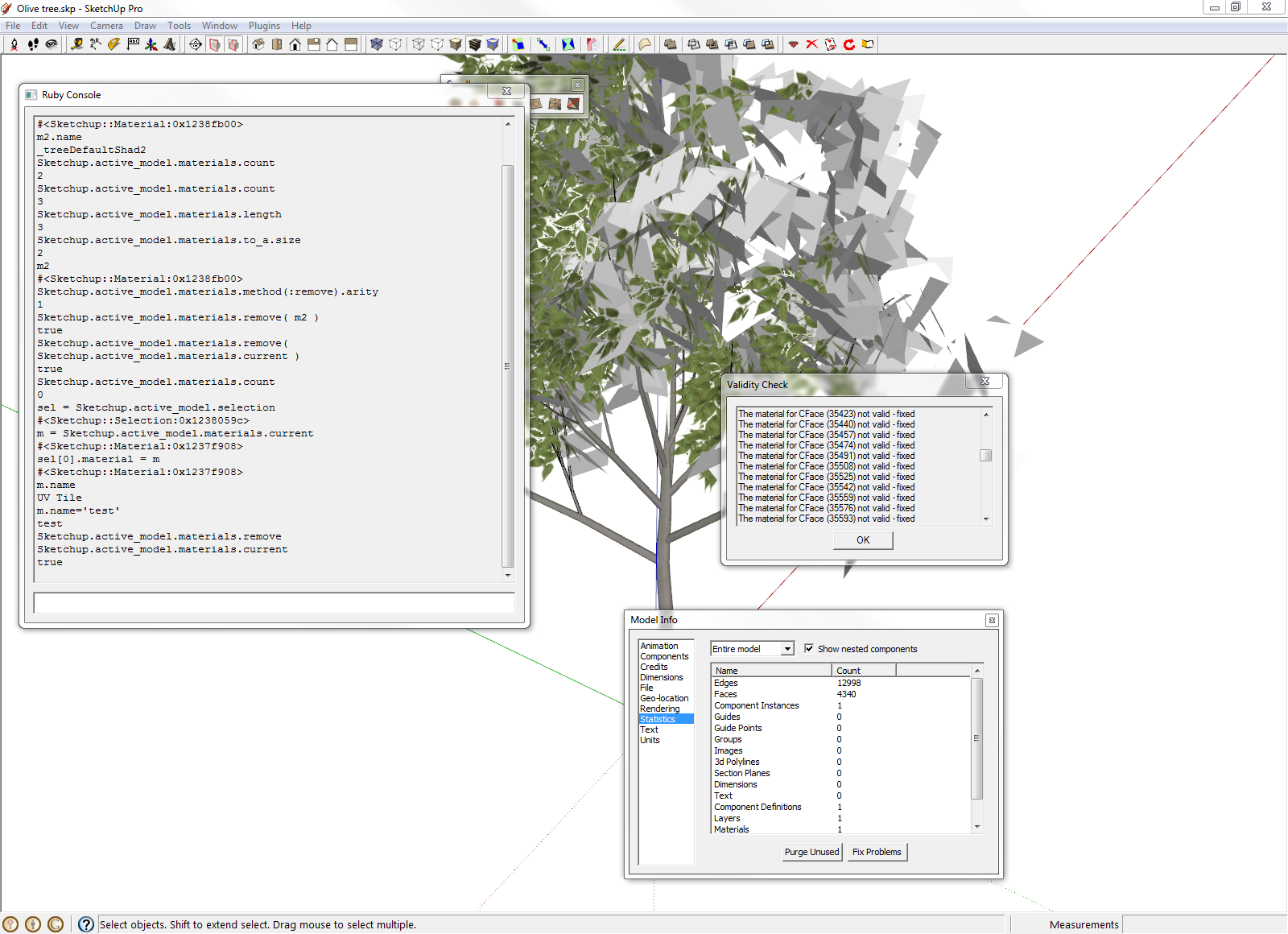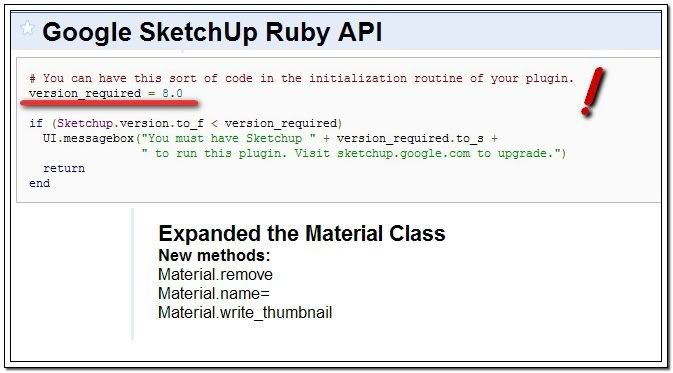New Material Methods! (With bugs :( )
-
http://code.google.com/apis/sketchup/docs/releases.html
@unknownuser said:
Expanded the Material Class
New methods:
Material.remove
Material.name=
Material.write_thumbnailNOTE: There's a type here: it's
Materials.remove(material)Bug Alert!

Sketchup::Materials.remove
When you erase a material withmaterials.removethe entities with the material doesn't revert back to default materials. The material disappear from the material list, but is still applied to materials in the model.
When you use "Fix Problem" it will report lots of invalid materials and it will then remove the material from the front side, but leave the back side with the invalid material.Workaround (annoyingly this means traversing the entire model - so it's not the fastest.)
<span class="syntaxdefault"><br />def self</span><span class="syntaxkeyword">.</span><span class="syntaxdefault">save_remove_material</span><span class="syntaxkeyword">(</span><span class="syntaxdefault"> material</span><span class="syntaxkeyword">,</span><span class="syntaxdefault"> model </span><span class="syntaxkeyword">)<br /></span><span class="syntaxdefault"> for e in model</span><span class="syntaxkeyword">.</span><span class="syntaxdefault">entities<br /> e</span><span class="syntaxkeyword">.</span><span class="syntaxdefault">material </span><span class="syntaxkeyword">=</span><span class="syntaxdefault"> nil if e</span><span class="syntaxkeyword">.</span><span class="syntaxdefault">respond_to</span><span class="syntaxkeyword">?(</span><span class="syntaxdefault"> </span><span class="syntaxkeyword">;</span><span class="syntaxdefault">material </span><span class="syntaxkeyword">)</span><span class="syntaxdefault"> </span><span class="syntaxkeyword">&&</span><span class="syntaxdefault"> e</span><span class="syntaxkeyword">.</span><span class="syntaxdefault">material </span><span class="syntaxkeyword">==</span><span class="syntaxdefault"> material<br /> e</span><span class="syntaxkeyword">.</span><span class="syntaxdefault">back_material </span><span class="syntaxkeyword">=</span><span class="syntaxdefault"> nil if e</span><span class="syntaxkeyword">.</span><span class="syntaxdefault">respond_to</span><span class="syntaxkeyword">?(</span><span class="syntaxdefault"> </span><span class="syntaxkeyword">;</span><span class="syntaxdefault">back_material </span><span class="syntaxkeyword">)</span><span class="syntaxdefault"> </span><span class="syntaxkeyword">&&</span><span class="syntaxdefault"> e</span><span class="syntaxkeyword">.</span><span class="syntaxdefault">back_material </span><span class="syntaxkeyword">==</span><span class="syntaxdefault"> material<br /> end<br /> for d in model</span><span class="syntaxkeyword">.</span><span class="syntaxdefault">definitions<br /> next if d</span><span class="syntaxkeyword">.</span><span class="syntaxdefault">image</span><span class="syntaxkeyword">?<br /></span><span class="syntaxdefault"> for e in d</span><span class="syntaxkeyword">.</span><span class="syntaxdefault">entities<br /> e</span><span class="syntaxkeyword">.</span><span class="syntaxdefault">material </span><span class="syntaxkeyword">=</span><span class="syntaxdefault"> nil if e</span><span class="syntaxkeyword">.</span><span class="syntaxdefault">respond_to</span><span class="syntaxkeyword">?(</span><span class="syntaxdefault"> </span><span class="syntaxkeyword">;</span><span class="syntaxdefault">material </span><span class="syntaxkeyword">)</span><span class="syntaxdefault"> </span><span class="syntaxkeyword">&&</span><span class="syntaxdefault"> e</span><span class="syntaxkeyword">.</span><span class="syntaxdefault">material </span><span class="syntaxkeyword">==</span><span class="syntaxdefault"> material<br /> e</span><span class="syntaxkeyword">.</span><span class="syntaxdefault">back_material </span><span class="syntaxkeyword">=</span><span class="syntaxdefault"> nil if e</span><span class="syntaxkeyword">.</span><span class="syntaxdefault">respond_to</span><span class="syntaxkeyword">?(</span><span class="syntaxdefault"> </span><span class="syntaxkeyword">;</span><span class="syntaxdefault">back_material </span><span class="syntaxkeyword">)</span><span class="syntaxdefault"> </span><span class="syntaxkeyword">&&</span><span class="syntaxdefault"> e</span><span class="syntaxkeyword">.</span><span class="syntaxdefault">back_material </span><span class="syntaxkeyword">==</span><span class="syntaxdefault"> material<br /> end<br /> end<br />end<br /></span>

-
@thomthom said:
http://code.google.com/apis/sketchup/docs/releases.html
@unknownuser said:
Expanded the Material Class
New methods:
Material.remove
Material.name=
Material.write_thumbnailNOTE: There's a typo here: it's
Materials.remove(material)You mean it's an instance method of the
Materialscollection. -
@thomthom said:
There's a type here: it's
Materials.remove(material)That's a great addition. I have some ideas that would greatly benefit from this...

-
but no retro compatibility


*s -
-
Just hope that no one had extended
Material.name=anywhere.
Dan: did you say there was a way to detect if a method had been overwritten? -
@thomthom said:
Just hope that no one had extended
Material.name=anywhere.
Dan: did you say there was a way to detect if a method had been overwritten?This is 'detected' in my additional class methods and the code only makes the new method if it doesn't already exist...
Amongst others there arematerial.name='newname',material.deleteandmaterial.save_thumbnail('filepath')that mimic these new methods in this v8 only... so they get made in earlier versions as needed - see http://forums.sketchucation.com/viewtopic.php?p=301258#p301258
Soclass Sketchup;;Material if not Sketchup;;Material.method_defined?(;name=) def name=(new_name=nil) ### etc code to rename material end#def end#if end#classetc etc
-
SO TIG you may wish to update your extension then to alias the method names
write_thumbnail()andremove()?? -
But there is no knowing of which other plugins has done this. There's a number of them that extended Group, Image and Array. It would be interesting to make a script that could scan the base classes for modification and map them. To get a feel of how the general state of the SU Ruby environment.
-
@thomthom said:
But there is no knowing of which other plugins has done this.
Dont say there is no way, just because you don't know how (..YET,) ... remember Ruby is cool! Ruby will find a way, or allow a way through it's immaculate dynamistic glory.

-
@dan rathbun said:
SO TIG you may wish to update your extension then to alias the method names
write_thumbnail()andremove()??I could - trust Google not to copy my naming conventions!
-
@tig said:
@dan rathbun said:
SO TIG you may wish to update your extension then to alias the method names
write_thumbnail()andremove()??I could - trust Google not to copy my naming conventions!
They could be following the conventions they have established already in the API .. although they didn't in this case (which really irks me to no end.. a quick check of the API methods index is all it takes.. before 'inventing' a new method..)
All the other thumbnail methods use "
save_thumbnail()"
"write" was used for images, textures, and IO operations, such as defaults to plist or registry."
remove()" was used when you 'dettached' an item from something else, but did not actually delete or dipose of it, as in an observer, or removing entity references from the selection set."
delete()" was used when you actually wanted to dispose of something, such as deleting an attribute, dictionary, or a set.So the question is.. did they follow their OWN conventions with these new methods??
-
And why would the delete method be part of
Materialsinstead ofMaterial? -
@thomthom said:
And why would the delete method be part of
Materialsinstead ofMaterial?Because
self.killis suicidal, socially unacceptable, and often religiously repugnant.Seriously, an object does not often dispose of itself, especially when it's a member of a collection. The collection class has a method(s) to dispose of one (or more,) of it's members. Ie
Arrayinstance methods:.shift,.pop,.sliceetc.... -
entity.erase!...

-
@thomthom said:
entity.erase!...

(1) that's not a Ruby method.. it's a Google written method (that doesn't really follow convention.)
(2) It uses the
**!**("in place",) suffix to denote the operation is immediate against the receiver... BUT it is actually just an alias forSketchup::Entities#erase_entities(receiver)

.. yes there are bound to be variances ... likely caused by human error. -
Cursed!
Materials.removeis bugged! http://forums.sketchucation.com/viewtopic.php?f=180&t=34217&p=301158#p301158 -
So
material.removedoesn't exist BUT is in the API docs ???
Thenmaterials.remove(material)exists but doesn't work as expected !!!What is going on ???
At least my 'clunky' old
material.deleteworks... and it reverts all objects that were using that material to have 'nil'! [but it does have to traverse all model.entities and definition.entities too to achieve it !] -
@tig said:
So
material.removedoesn't exist BUT is in the API docs ???Yes - the docs where wrong.
@tig said:
At least my 'clunky' old material.delete works... and it reverts all objects that were using that material to have 'nil'! [but it does have to traverse all model.entities and definition.entities too to achieve it !]
Yea. When using
Materials.removeyou still need to iterate the whole model, but at least one doesn't ahve to create temp groups and use purge.
Too bad this method is bugged when it finally appeared.But
material.name=seem to work fine. Which is very good as one doesn't need to clone a new variant of the material. -
@tig said:
Then
materials.remove(material)exists but doesn't work as expected !!!What is going on ???
It is working as intended. It would all make sense if you guys could see how the Ruby API is implemented in SU.
The Ruby API is a very thin wrapper around our C++ code. So in this case we have a CMaterialManager class
in SU and the Ruby Materials class wraps CMaterialManager. When you get Materials from the model you get the
Ruby wrapper around CMaterialManager. CMaterialManager knows nothing about the model. Its just
a std::vector<CMaterial*> CMaterialVec; and all Materials.remove does is call
CMaterialManager.RemoveMaterial(CMaterial*), which just removes the given material from the CMaterialVec.
What everyone is asking for is probably a new method in model called model.remove_material (you guys can start
another thread on what it should be called). This new method would live in model because
model owns Materials and the entities that are assigned the materials. So model has all the info
needed to implement what you are asking for. Sorry for messing this up, I sneaked these new methods
in right before release which didn't get properly reviewed by the beta group because there were no
release notes made for the new methods.
Advertisement








